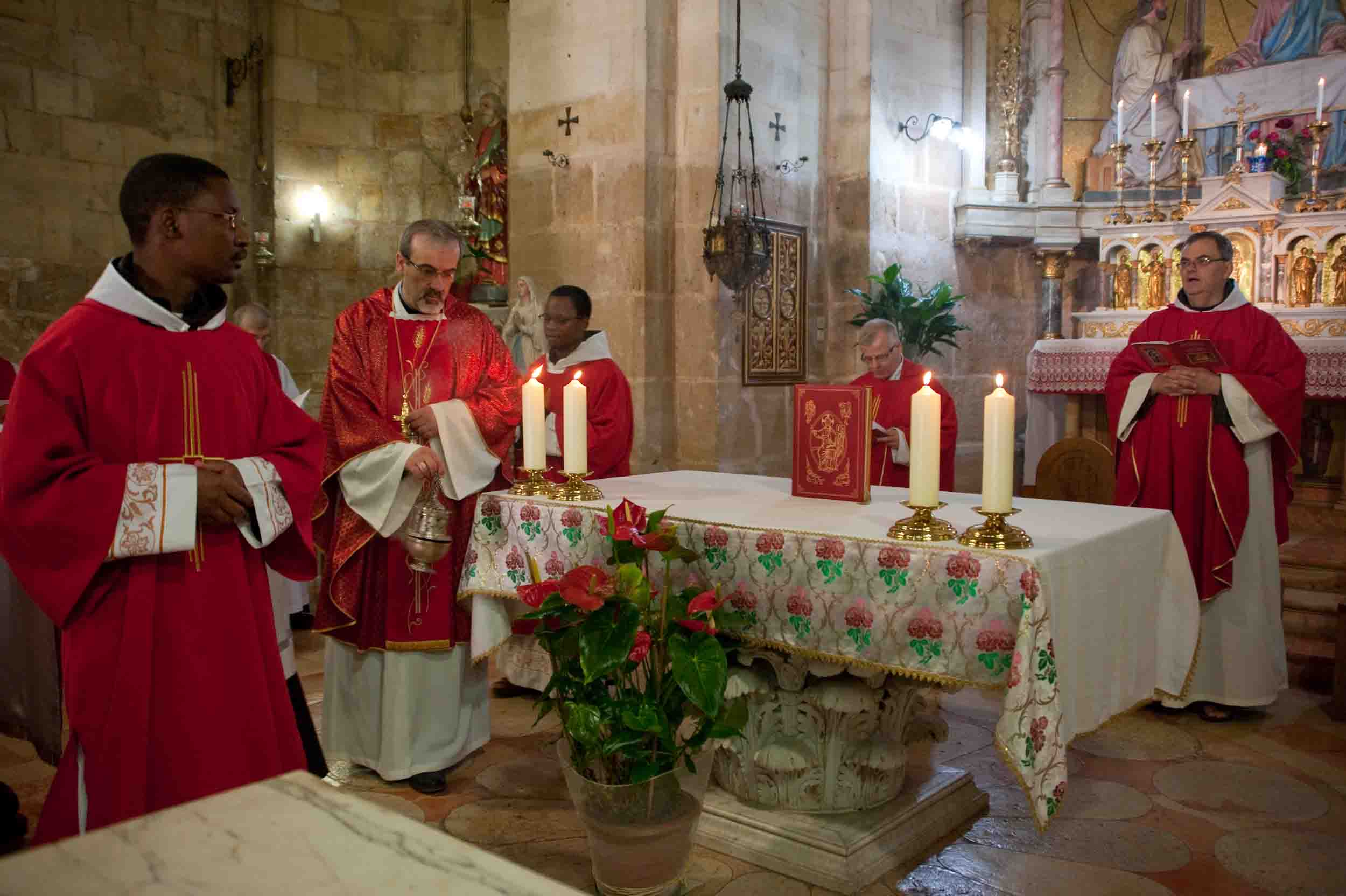
Sunday, 29 September. In the little Arab village of Emmaus Al-Qubeibe, a dozen kilometers from Jerusalem, the Franciscans completed the pilgrimage dedicated to the memory of Saints Cleopas and Simeon. According to tradition and the writings of the historian Eusebius of Caesarea, Cleopas would have been the brother of Joseph, the husband of the Virgin Mary. In Luke’s gospel (24:18), he is listed as one of the two men to whom Jesus appeared after the discovery of the empty tomb. An uncle of Jesus, he was also the father of Simeon, the future bishop of Jerusalem, who was present when Christ appeared on the road to Emmaus. Eusebius of Caesarea refers to him as “the cousin of the Lord”. The two disciples, devastated by the death of Christ, had left the Holy City and set out for Emmaus, to Cleopas’ home. Meeting Jesus, whom they did not recognize, they offer him hospitality and share their meal with him. It is there that they recognize him, not having recognized him while they mourned.
A number of Holy Land villages lay claim to the title of the biblical Emmaus. Al-Qubeibe, under Crusader rule from the 12th century, has been considered the town where Christ appeared since 1280. The Franciscans presence there began in the 15th century. There they discovered the ruins of a both a Byzantine church and an ancient Crusader church, where the supposed remains of Cleopas’ house are conserved. That is where they erected the Sanctuary of the Manifestation of the Lord.
Located in the Palestinian Territories, the site is very difficult to access today. The traditional routes were closed by the Israeli wall of separation, necessitating long, complicated detours. Consequently, pilgrims have decided to forego it. Only the Franciscans, accompanied by a few male and female religious, volunteers and friends, participated in the ceremony, initially set for September 24th but traditionally celebrated by the friars on the closest Sunday to that date.
Mass began at 10:30. Presiding was the Custos of the Holy Land, Fra Pierbattista Pizzaballa, assisted by the new guardian of Saint Saviour Convent in Jerusalem, Fra Stéphane Milovitch. A sparse but powerful Mass, carried by the Christian characteristic of faith in the Resurrection.
In his homily, the Custos referred to the “frustration” of the Emmaus disciples: if Jesus had been a prophet, powerful “in words and acts”, he was one no less, having been killed. But Christ, in a true catechesis, explains that this is “what had to happen”. Their hearts were “slow to believe” (Lk 24:25); they did not recognize him. Fra Pizzaballa cautioned, “Cleopas’ attitude and difficulties are also our own. […] We construct our own Jesus” but we have to “crucify” our fantasies or we cannot “recognize him in truth”. The Custos affirmed that in order to recognize “the Lord in our life”, we have to give ourselves to him, that is, “recognize ourselves as Church” because, the Custos continued, “it is in the Eucharist that Christ appears in his wholeness,” just as it was in breaking the bread that Jesus was recognized by the two disciples. Faith does not consist in following him as a prophet who was sacrificed, but in living “the life of the Lord who was resurrected and who resurrects us, the Lord whom we recognize in the Eucharist.”
After Mass, the assembly shared Sunday lunch in the sanctuary before returning to Jerusalem.
S.C.
A number of Holy Land villages lay claim to the title of the biblical Emmaus. Al-Qubeibe, under Crusader rule from the 12th century, has been considered the town where Christ appeared since 1280. The Franciscans presence there began in the 15th century. There they discovered the ruins of a both a Byzantine church and an ancient Crusader church, where the supposed remains of Cleopas’ house are conserved. That is where they erected the Sanctuary of the Manifestation of the Lord.
Located in the Palestinian Territories, the site is very difficult to access today. The traditional routes were closed by the Israeli wall of separation, necessitating long, complicated detours. Consequently, pilgrims have decided to forego it. Only the Franciscans, accompanied by a few male and female religious, volunteers and friends, participated in the ceremony, initially set for September 24th but traditionally celebrated by the friars on the closest Sunday to that date.
Mass began at 10:30. Presiding was the Custos of the Holy Land, Fra Pierbattista Pizzaballa, assisted by the new guardian of Saint Saviour Convent in Jerusalem, Fra Stéphane Milovitch. A sparse but powerful Mass, carried by the Christian characteristic of faith in the Resurrection.
In his homily, the Custos referred to the “frustration” of the Emmaus disciples: if Jesus had been a prophet, powerful “in words and acts”, he was one no less, having been killed. But Christ, in a true catechesis, explains that this is “what had to happen”. Their hearts were “slow to believe” (Lk 24:25); they did not recognize him. Fra Pizzaballa cautioned, “Cleopas’ attitude and difficulties are also our own. […] We construct our own Jesus” but we have to “crucify” our fantasies or we cannot “recognize him in truth”. The Custos affirmed that in order to recognize “the Lord in our life”, we have to give ourselves to him, that is, “recognize ourselves as Church” because, the Custos continued, “it is in the Eucharist that Christ appears in his wholeness,” just as it was in breaking the bread that Jesus was recognized by the two disciples. Faith does not consist in following him as a prophet who was sacrificed, but in living “the life of the Lord who was resurrected and who resurrects us, the Lord whom we recognize in the Eucharist.”
After Mass, the assembly shared Sunday lunch in the sanctuary before returning to Jerusalem.
S.C.

